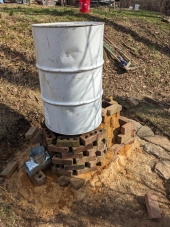What you are talking about is turning it into caliche (
https://en.wikipedia.org/wiki/Caliche). And yes, caliche is quite a durable building material, but not so great to try to grow things in. You are a bit north of the zones of caliche in the southwest, but if you ever get down to eastern New Mexico or West Texas, you can run into formations of it.
How much lime do you have to add to your soil to get it to firm up? I would start at 2% by volume and see what that does, and then scale up from there, if needed. When lime is used to stabilize road beds, they generally work in the 3-6% range. Here's a reference on
Lime Treated Soil Construction which can get you started.






